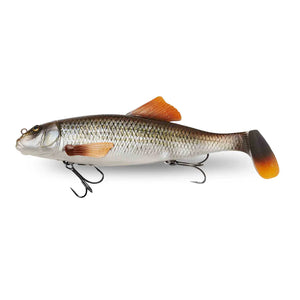Musky fishing is a thrilling and challenging endeavor that requires a unique set of skills and techniques. One of the most effective techniques for catching musky is the Figure 8 Technique. This technique involves making a figure 8 pattern with your musky rod & lure at the end of the retrieve, it’s known for its ability to entice musky to strike.
The figure 8 technique is best used with large, surface-swimming musky lures such as topwater plugs, bucktail spinners, or large soft plastic baits. These musky lures are designed to mimic the movement and appearance of large prey, such as fish or small mammals, that musky feed on.
To begin, cast your lure out into the water and retrieve it slowly, allowing it to swim near the surface. As you near the end of the retrieve, slowly lift your rod tip up, then sweep it to the left, and then back to the right in a figure 8 pattern. This motion creates a disturbance on the surface of the water and simulates the panicked movements of an injured or fleeing prey, which can trigger a musky's predatory instincts.
As you make the figure 8, keep your rod tip high and your line tight. This allows you to feel the slightest bump or tap, which could indicate a musky has taken the bait. If you feel a bite, wait a moment before setting the hook, as musky have a tendency to take the bait, then release it before they swallow it.
The figure 8 technique is not only effective but also a fun way to fish for musky, as it allows you to actively engage with your lure and play with the fish. It's important to keep in mind that musky are elusive and powerful fish, so you'll need to use a strong rod and musky reel that can handle the fight.
When it comes to musky fishing, the figure 8 technique is a go-to method for many anglers. It's a proven method for catching musky, but to truly master it, there are a few tips and strategies that can help increase your chances of success.
- Timing is everything: The figure 8 technique is best used at the end of the retrieve, when the lure is near the surface and the musky is most likely to strike. Pay attention to the time of day, and try to fish during the times when musky are most active.
- Vary your retrieve: Musky can be finicky and may not respond to the same retrieve every time. Experiment with different speeds, depths, and angles when making the figure 8.
- Use the right equipment: Musky are powerful fish and require strong, high-quality equipment to handle the fight. Make sure to use a rod and musky reel that are appropriate for the size of the musky you are targeting.
- Pay attention to the weather: Weather conditions can greatly affect musky behaviour. Fish tend to be more active on overcast or rainy days, while they may be less active on bright, sunny days.
- Fish around structure: Musky often hold near structure such as weed beds, logs, rocks, and drop-offs. Focus on these areas when fishing, as they are likely to hold more fish.
- Change your Lure: If you are not getting any bites, change your lure. Musky can be very selective in what they want to eat, and a different color, size or action can make a big difference.
- Stay patient: Musky fishing can be a waiting game, so it's important to stay patient and keep trying different methods and strategies until you find what works.
Overall, the figure 8 technique is a proven method for catching musky, one of the most sought after and challenging freshwater fish to catch. It requires a bit of patience and practice, but with the right musky equipment and proper technique, you'll be well on your way to landing that trophy musky. Remember to always fish responsibly and respect the environment, as musky populations are fragile and need to be protected.








